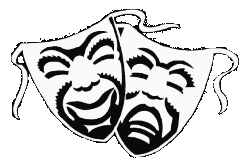

|
Photo Gallery Archive
|
(Reverse chronological order is employed so that photos
of the most recent events will be displayed first.)
Lucky Stiff
Dartmouth Players
Sawmill Playhouse,
Dartmouth, NS
2019, June
(80mm fresnels are 200 watts.
150mm fresnels are 500 watts.
Ellipsoidals are 500 watts
and are 115mm, Zoom models.)
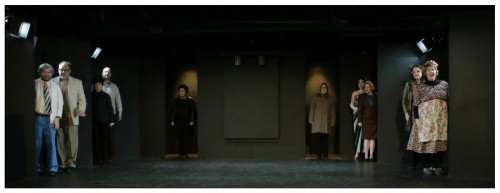 Six fresnels, three on each side, wash the stage from the side entrances. These have Steel Blue gel. The upstage actors do not have this same side wash because there was not enough available dimmer channel capacity to accommodate two more lights. Front lighting is from three front-of-house (FOH) fresnels using a Straw tint along with Silk Diffusion to both widen and soften the beams. The open doorways each have one 80mm fresnel in Colour Correction Orange to create cones of light down the walls. |
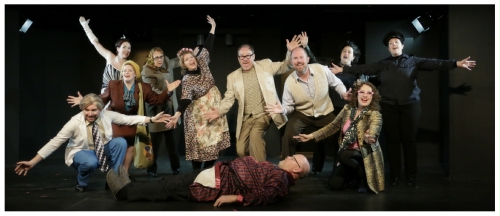 Lighting is the same here as in the previous photo. The effect of the side wash shows how well it fills in all around each of the actors. This is important given that the two main FOH washes come from straight on. Without the side lighting, audience members off to the sides (especially those in the down-house seating) would see the side of each actor be shadowed. This can be seen in the next photo where no side wash was used. |
![(Image: A London Tube [subway] Scene on the
Left; a Kitchen Scene is on the Right)](../../Images/Artists/Stiff/TubeHome.jpg) Each area must be kept separate as audience members watch two scenes taking place at the same time. Single ellipsoidals in open white (no colour) provide a front light for each area from the front of house. Four 80mm fresnels at center stage illuminate the area in between. These have Pale Violet gel. In addition, the kitchen flat in behind has a single fresnel placed in the entrance way closest to it. An amber gel highlights the `wallpaper' colours. |
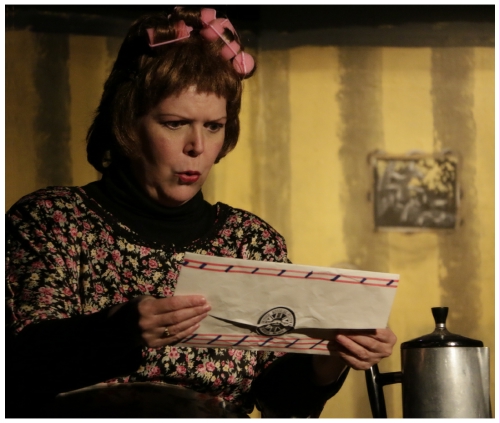 This closeup shows the effect of the front lighting and of that on the flat, as described above. |
 A train in daylight is created with the Straw front wash, and One-Half Colour Correction Blue comes from above using four 80mm fresnels. |
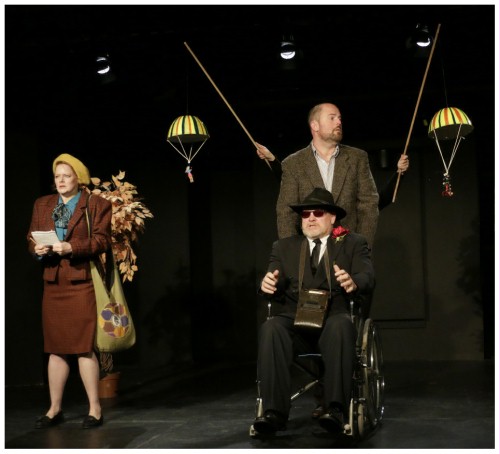 The same lighting as the train is used for this look. |
 This is again the same lighting as the above two scenes, but the open doorways behind use the 80mm fresnels to downlight the open areas seen past the rear wall. Fabric has been placed there to differentiate scenes not in the hotel. |
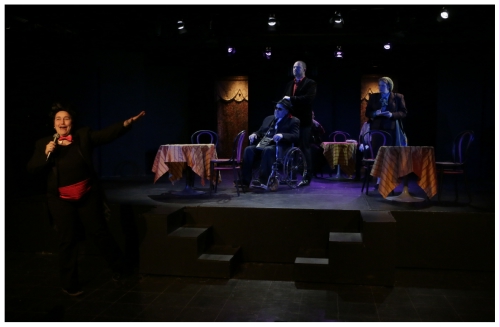 Four 150mm fresnels above the audience in Colour Correction Orange illuminate the main floor. Having four lights, allows enough coverage for the MC to travel the full width of the seating area. Some of this wash also catches the fronts of the tables because the focus must be high enough to light the MC's face when he gets close to the stage. The stage itself represents a night club seating area with a Medium Blue as the main lighting from four fresnels, two each at the side corners of the front-of-house area. Downstage back lighting comes from four 80mm fresnels in One-Half Colour Correction Blue, while four more illuminate the upstage table in a Dark Lavender. These eight backlights are seen as two arcs above the heads of the on-stage actors. Upstage doorway lighting is as previously described. |
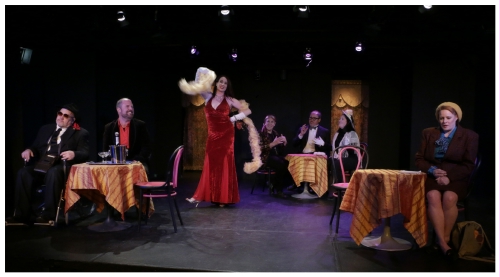 All lighting is as in the previous photo, but the floor lights are now out and front lighting has been brought up a bit to provide facial light. This consists of one ellipsoidal for each downstage table as used in the Tube/Kitchen scene, and an additional center ellipsoidal for the singer. All are no colour. |
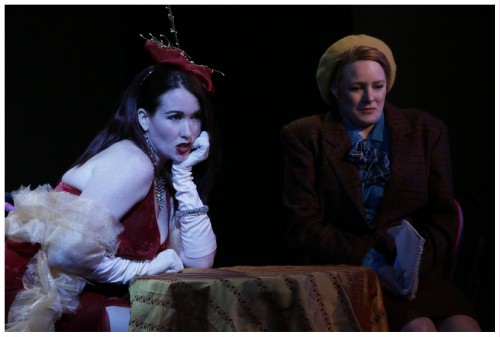 The lighting on Annabel's table is as above, but the singer has verbally requested a blue spotlight to be brought up on her. A single ellipsoidal is used so as to keep the lighting separate on each character even though they are close together. Daylight Blue is the chosen colour because it is not so deep as to take away detail, yet still shows a distinctly blue cast. |
 This closeup shows the club lighting as it appears near the extreme upstage. The FOH Blue wash reaches all the way there, while the four 80mm fresnels cast Dark Lavender from the above behind and above sides. The doorway Colour Correction Orange from a single 80mm fresnel shines on fabric. |
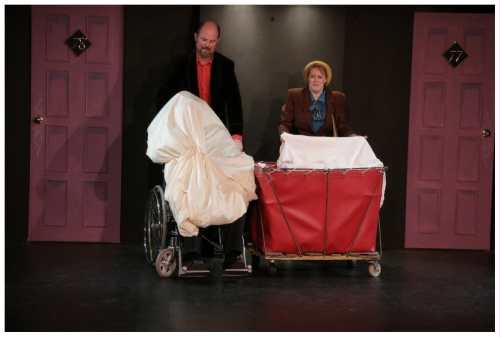 A change of look here represents a hotel corridor. Front lighting uses Flesh gel to give a more warm, interior feel. This comes from three 150mm FOH fresnels, while two more mid-stage ones boost light levels at this extreme upstage position. Side lighting in Steel Blue comes from off stage by one fresnel on each side. The down lights on the back wall are two 50-watt, PAR 20 floods in houshold, flat ceiling-sockets. These are masked with plastic ice-cream style containers that have had the bottoms removed and been painted flat black. |
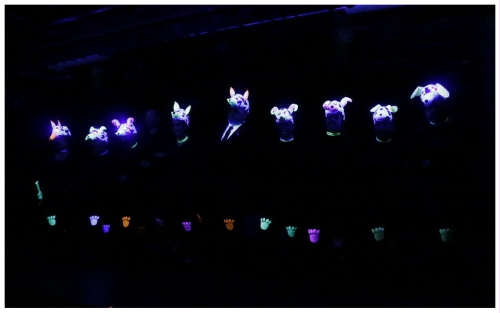 This is strictly an ultraviolet effect with no other lighting save for dim, LED `eyes' in the masks. There are four fixtures with twin, filtered, T12 fluorescent blacklight tubes in each. These were chosen for their high output, excellent visible-light filters, and their wide-angle coverage at such a short distance. All are mounted above and downstage of the actors. |
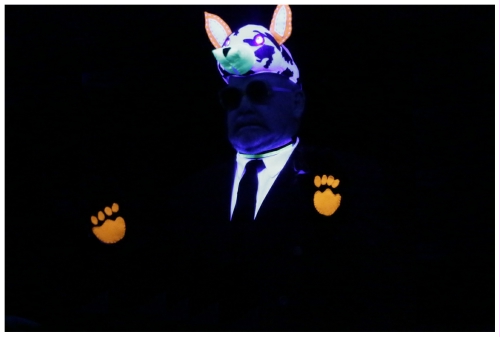 A closeup of this UV lighting on a single actor shows how powerful the effect is, and how well the filters keep visible light from diluting the scene. His face, glasses, suit coat, and his tie all remain very dark. |
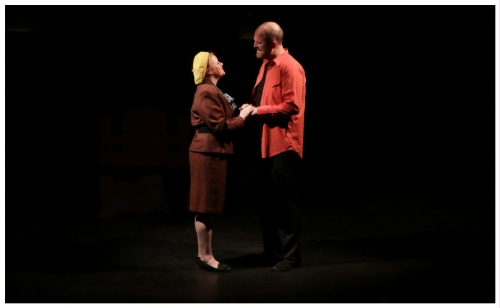 SImple lighting often works the best. Here, the two lead actors are illuminated by two 80mm fresnels in a Gold tint, one from each side and above, and both slightly downstage of their positions. Each actor's back light is the other's front light. |
 This is the same lighting as above. The tendency for most designers would be to add some front fill light so as to bring the faces out of the dark. However, allowing them to descend into shadow as the kiss progresses, gives a `privacy' feel to this tender moment. |
Wizard of Oz
Bicentennial School
Keating Hall,
Dartmouth, NS
2019, May
(All lights are 500 watts unless otherwise noted.
All Fresnels are 150mm and have Barndoors.
All Ellipsoidals are 35-Degree except where noted.
Front Wash Fixtures per Colour are two 1000-watt,
Short-Throw PAR 64s with Wide Flood Lamps.)
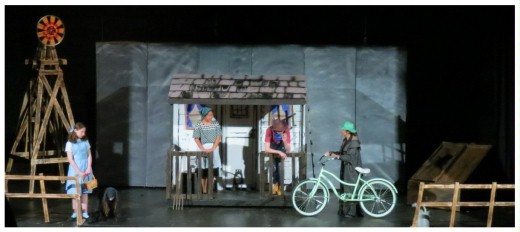 To give Kansas a "black and white" feeling, the stage is washed using a One-Half Colour-Correction Blue. No back lighting is employed so as to give the set and actors a flatter, one-dimensional look. The height of wind turbine blades meant they were shadowed by the front border curtain. A fixture hung on the mid-stage pipe would bring them out of the dark, but because of its closeness to the blades, the light projected had to be wide, soft, and not too bright. A PAR 38 fixture with a 120-watt `R' floodlamp was chosen. The light Blue of the front wash was duplicated so that the lighting would match. Adding this PAR 38 fixture illustrates how lighting is employed after the initial design phase to alternately highlight, de-emphasise, or in this case, correct issues. |
 In Oz, the colours have been made brighter and more saturated. The front wash is a Bastard Amber, while Pink back lighting is provided by three, 400-watt fresnels that wash the entire stage from behind. Their effect is seen here on the roof of the house, and head, shoulders and arms of Glinda the Witch. |
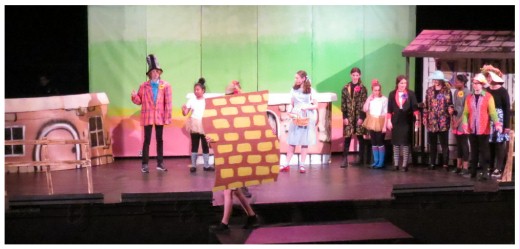 The lighting is as above, but white center light has been added from two front-of-house (FOH), 200mm ellipsoidals and a single fresnel directly over the same area. This wider angle photo also shows the effect of the back Pink wash on the main and thrust stages. |
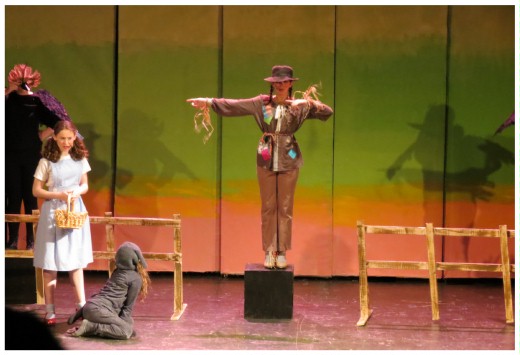 While the top white light and Pink back wash remain, the FOH center lights are off and the Bastard Amber front wash has been dimmed. This illustrates how changing the balance of light alters the feel of a scene. Even though little differs from the previous two photos lighting-wise, there is a different feeling here. |
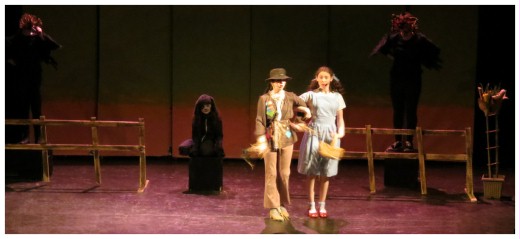 The pink wash remains. The front and top lighting have been removed, and an apron wash in a Straw colour from an FOH pipe just in front of the stage keeps the main lighting strictly on Dorthy and Scarecrow. Toto and the crows recess into the background due to lower light levels on them. By having the Downstage apron wash come in from the extreme upper sides, this light is kept away from the upstage and so attention is given to the dance by Dorthy and the Scarecrow. |
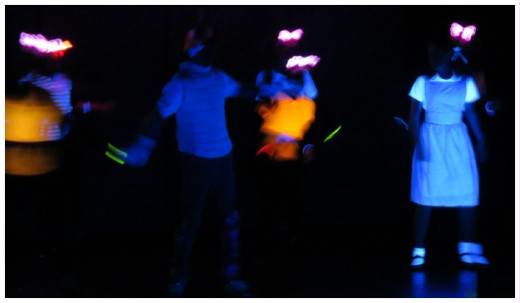 The only lights here are four blacklights (ultraviolet) to make fluorescent parts of the costumes glow. Four were used on the stage floor so as to cover the area required, but also because it was not feasible to hang the fixtures. Each fixture uses white reflectors with twin high-output, T12 fluorescent tubes. These have 80% filters, meaning that 80% of visible light has been filtered out so as to improve the contrast of the effect. |
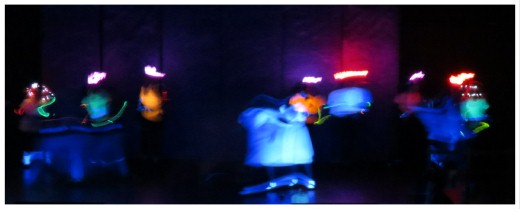 A wider view of the above. Dancers blur the camera exposure here due to their fast movement. Notice the secondary glow on the upstage flats on the right. This is coming from the visible light emitted by parts of the fluorescing costumes. A dim violet can also be seen on some of the flats; this is from the visible component of the ultraviolet lamps. |
 A Dark Blue washes the stage from the FOH, while four ellipsoidals with foliage patterns cover the actors and back flats. These use Quarter, Colour Temperature Blue gels to give a light moonlight effect. |
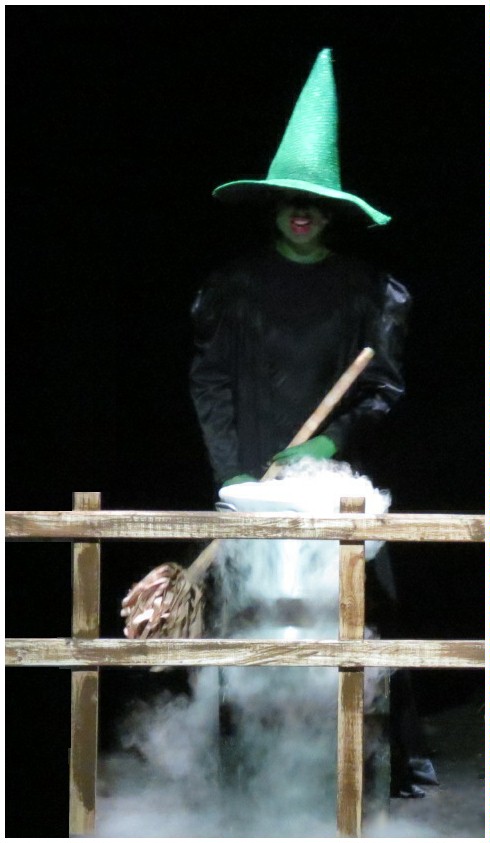 This extreme closeup shows the Wicked Witch of the West lighted in a Steel Green to highlight her green hat and makeup. A PAR 64 medium flood from the FOH is rotated to its horizontal orientation so as to cover her and leave enough room for the flying monkees, not in this scene. Her upper face has been allowed to be in shadow to give her a more ominous look. From behind, a single ellipsoidal with a breakup pattern allows shadow to play upon her, and also the other actors when present. To continue the cool look of her castle, a Blue Correction filter lightly colours this breakup. The steaming cauldron is created using a simple dry ice and hot water combination just before lights up. |
 The FOH wash is Dark Blue, as seen on the Emerald City Choir Members, while the main cast is lighted by the two FOH ellipsoidals and a top white fresnel above Center Stage. A strong side wash from four PAR 64 medium floods casts a bright yellow across the stage from each wing. This is most evident on Witch Glinda. A bit of the rear pink is used to add more colour. Upstage of the flats are two 500-watt PAR 56 medium floods projecting lime green slashes down the back wall to suggest Emerald City. Because the rear wall is black, it does not reflect well at all angles, and so the left beam appears weaker to the camera position. |
|
Photos are by Bruce Goodick of Halifax and Richard Bonner of Dartmouth. |
|
Return to the |
Return to the |
|
Go to the |
|